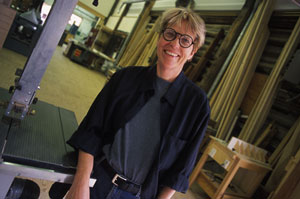
It’s a long way, in two dimensions, from sea level in the Bay Area to Snowmass Village in the Colorado Rockies. Luckily, Susan Working is a multi-dimensional person, so she hasn’t had much of a problem with the transition. This accomplished artist and businessperson is the new director of the woodworking program at Anderson Ranch, a critical center of learning in the woodworking world.
We sat down recently with Working and asked her about her plans for the Ranch program, and her observations on general trends in the world of woodworking.
Background Check
With an MFA in furniture design from the Rhode Island School of Design, Working has taught at RISD, the California College of Arts and Crafts, and Laney College in Oakland. Before that, she owned and operated a successful furniture design and fabrication business in the San Francisco Bay area, which she ran for more than 10 years. More recently, she exhibited with woodworker Stephen Proctor at the Tercera Gallery in Palo Alto, California, and her work will be featured in an upcoming book on contemporary furniture by Michael Hosaluk, being published this fall.
Mixed Media
While she definitely has her own agenda for the future of the woodworking program, Working also recognizes the value of what she is inheriting.
“I think Gail Fredell (the former director) built a strong wood program at the Ranch during her tenure here”, she said. “I’m fortunate to be in a position of building on that very sound foundation.”
A strong personality with a lot of hands-on experience, Working will undoubtedly leave her own personal stamp on the program. With her background in mixed media, it’s no surprise that she envisions a certain amount of experimentation in the woodshop.
“I personally work in a wide range of media, and I see more and more woodworkers mixing media in their work … adding metal, paint, textiles and so on. There is also a lot of interest in developing and inventing sustainable materials and methods of work. For example, there seems to be a lot of interest in creative uses of recycled materials, salvaged woods and certified woods.
And there is a desire for information about sources and characteristics of the new, ecologically sensitive materials we are seeing in the industry, such as sunflower board and wheatboard. Plus, of course, there is a huge amount of interest in non-toxic, environmentally sensitive methods of finishing.”
A New Outlook
New materials aren’t the only trend Working sees in the woodshop. Perhaps it’s that global economy we keep hearing about, or the blossoming of the Internet, but she definitely notes a change in attitudes … a desire to break down barriers and explore new methods.
“Along with what I think is a related interest in hand tools and pre-industrial techniques” she says, “I think America’s woodworkers are now more curious about non-Western methods, techniques, tools and design philosophies.
“I believe people who are interested in woodworking are generally pretty soulful: they’re looking for that hand-body-spirit connection that David Pye describes so eloquently in his essay “The Workmanship of Risk”: Whether they use machines or hand tools makes little difference. The risk remains, and the search for a voice.
Hands-On Solutions
While the Ranch is a very progressive, innovative campus with significant past successes, woodworkers generally have a reputation for being a little conservative. Given their somewhat tenuous reluctance to experiment, how does Working see her role in encouraging mixed media in the woodshop?
“I’m committed to developing workshops which address this” she says. “As director, I will actively encourage investigations in mixing media, in cross-cultural fertilization, and in environmental education and research. The workshop we had this summer, Incorporating Metal and Wood, is a good example. It focused on low tech metalworking techniques (really, almost 19th century methods), which could be all be done in a basic garage or home woodshop with minimal tooling. To tell the truth, that workshop was a lot of fun.”
Mixing the Old with the New
Working is obviously excited about possibilities for change, but she also is a strong believer in preserving the traditional way of doing things. The Ranch has, for almost half a century, passed along the accumulated learning and wisdom of some of the planet’s premier woodworkers. The students and faculty have always had a strong grounding in traditional methods.
“We will always offer good, solid basics in the techniques and joinery of woodworking,” she told us. “After all, you have to know how to construct, before you can deconstruct! But we will try to stretch the imagination, and expand the language. For example, next summer, the Ranch will offer a workshop with Osumu Shoji, master woodworker and teacher, who is the Director of the Shinrin Takumijuku School of Woodworking in Japan. That would make an interesting story: perhaps the Journal can visit again while he’s here?”
(Ed note: we’d love to!)







